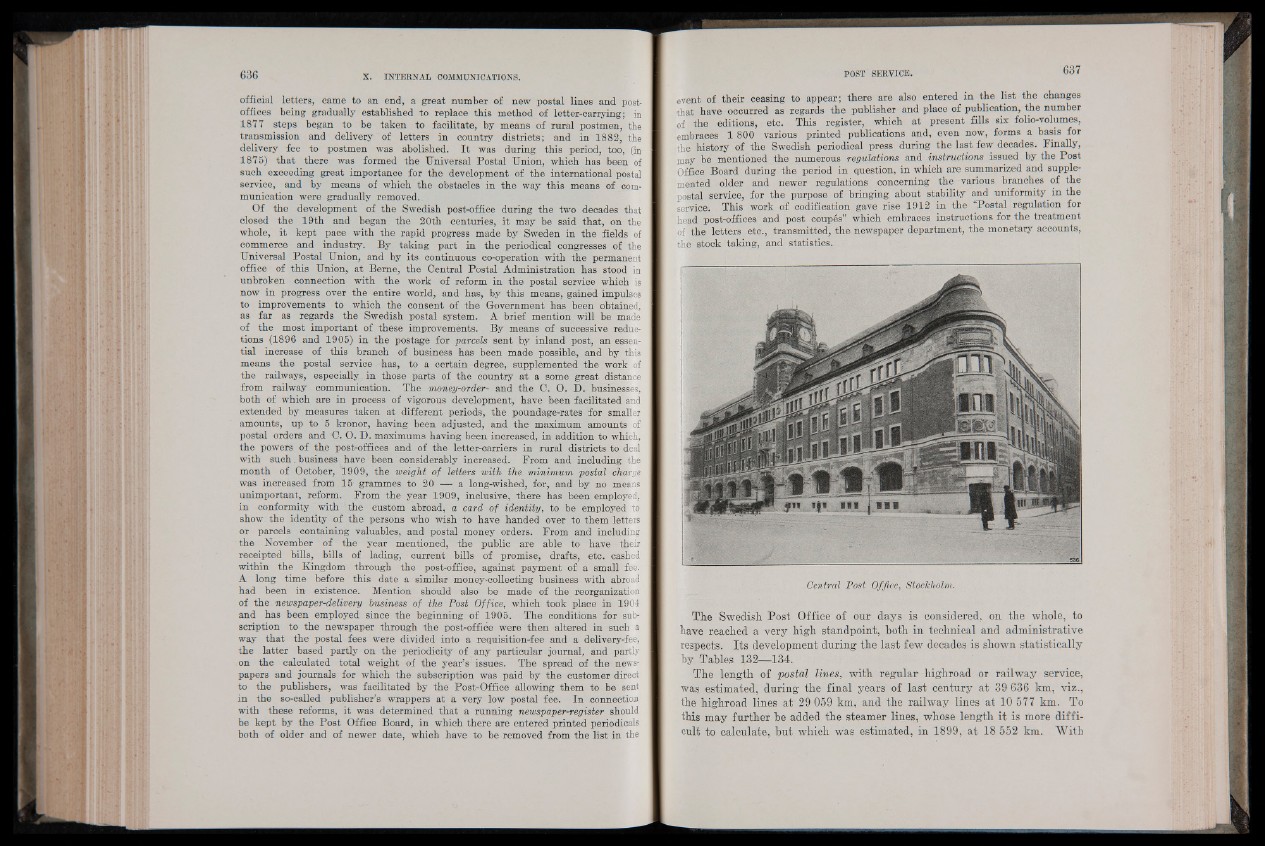
official letters, came to an end, a great number of new postal lines and post-
offices being gradually established to replace this method of letter-carrying; in
1877 steps began to be taken to facilitate, by means of rural postmen, the
transmission and delivery of letters in country districts; and in 1882, the
delivery fee to postmen was abolished. I t was during this period, too, (in
1875) th a t there was formed the Universal Postal Union, which has been of
such exceeding great importance for the development of the international postal
service, and by means of which the obstacles in the way this means of communication
were gradually removed..
Of the development of the Swedish post-office during the two decades that
closed the 19th and began the 20th centuries, it may be said that, on the
whole, it kept pace with the rapid progress made by Sweden in the fields of
commerce and industry. By taking part in the periodical congresses of the
Universal Postal Union, and by its continuous co-operation with the permanent
office of this Union, at Berne, the Central Postal Administration has stood in
unbroken connection with the work of reform in the postal service which is
now in progress over the entire world, and has, by this means, gained impulses
to improvemeîrts to which the consent of thé Government has been obtained,
as far as regards the Swedish postal system. A brief mention will be made
of the most important of these improvements. By means of successive reductions
(1896 and 1905) in the postage for parcels sent by inland post, an essential
increase of this branch of business has been made possible, and by this
means the postal service has, to a certain degree, supplemented the work of
the railways, especially in those parts of the country at a some great distance
from railway communication. The money-order- and the C. O. D. businesses,
both of which are in process of vigorous development, have been facilitated and
extended by measures taken at different periods, the poundage-rates for smaller
amounts, up to 5 kronor, having been adjusted, and the maximum amounts of
postal orders and C. O. D. maximums having been increased, in addition to which,
the powers of the post-offices and of the letter-carriers in rural districts to ’deal
with such. business have been considerably increased. From and including the
month of October, 1909, the weight of letters with the minimum postal charge
was increased from 15 grammes to 20 — a long-wished, for, and by no means
unimportant, reform. From the year 1909, inclusive, there has been employed,
in conformity with the custom abroad, a card o f identity, to be employed to
show, the identity of the persons who wish to have handed over to them letters
or parcels containing valuables, and postal money orders. From and including
the November of the year mentioned, the public are able to have their
receipted bills, bills of lading, current bills of promise, drafts, etc. cashed
within the Kingdom through the post-office, against payment of a small 5 fee.
A long time before this date a similar money-collecting business with abroad
had been in existence. Mention should also be made of the reorganization
of the newspaper-delivery business of the Post Office, which took place in 1904
and has been employed since the beginning of 1905. The conditions for subscription
to the newspaper through the post-office were then altered in such a
way that the postal fees were divided into a requisition-fee and a delivery-fee,
the latter based partly on the periodicity of any particular journal, and partly
on the calculated total weight of the year’s issues. The spread of the newspapers
and journals for which the subscription was paid by the customer direct
to the publishers, was facilitated by the Post-Office allowing them to be sent
in the so-called publisher’s wrappers at a very low postal fee. In connection
with these reforms, it was determined th a t a running newspaper-register should
be kept by the Post Office Board, in which there are entered printed periodicals
both of older and of newer date, which have to be removed from the list in the
event of their ceasing to appear; there are also entered in the list the changes
that have occurred as regards the publisher and place of publication, the number
of the editions, etc. This register, which at present fills six folio-volumes,
embraces 1 800 various printed publications and, even now, forms a basis for
the history of the Swedish periodical press during the last few decades. Finally,
may be mentioned the numerous regulations and instructions issued by the Post
Office Board during the period in question, in which are summarized and supplemented
older and newer regulations concerning the various branches of the
postal service, for the purpose of bringing about stability and uniformity^ in the
service. This work of codification gave rise 1912 in the “Postal regulation for
head post-offices and post coupés” which embraces instructions for the treatment
of the letters etc., transmitted, the newspaper department, the monetary accounts,
the stock taking, and statistics, .
Central Post Office, Stockholm.
The Swedish Post Office of our days is considered, on the whole, to
have reached a very high standpoint, both in technical and administrative
respects. Its development during the last few decades is shown statistically
by Tables 132—134.
The length of postal lines, with regular highroad or railway service,
was estimated, during the final years of last century at 39 636 km, viz.,
the highroad lines at 29 059 km, and the railway lines at 10 577 km. To
this may further be added the steamer lines, whose length it is more difficult
to calculate, but which was estimated, in 1899, at 18 552 km. With